Nodes of passage of ventilation exhaust shafts: types, features of the choice, application and installation of penetration
Each building, regardless of purpose, is equipped with supply and exhaust ventilation. At low air speeds, dampness, mold, and unpleasant odors appear. Over time, the destruction of load-bearing elements begins, the life of the structure decreases, various utilities fail.
To ensure that the system works without interruptions, moisture does not penetrate into the channels, the nodes of the passage of ventilation exhaust shafts are installed. The points of intake, air discharge are located at the highest places. Often, a roof is chosen for their installation. But what are these nodes and how to install them correctly?
We will talk about this in detail in our article - we will consider the types of nodes, the features of their application, the technology for venting through the roof. This information will help to avoid errors that are made by inexperienced users when choosing items, installing them, which leads to the appearance of serious defects, disruption of the entire system.
The content of the article:
Features of ventilation passage units
Exhaust ventilation in a private house and a small public building can be represented by a complex, branched duct system. They can be combined into common channels or brought out independently.
In order for the exhaust air to leave the building unhindered, a through hole must be made in the roof. Such a passage needs warming, high-quality sealing, and other arrangement measures.
If there are defects during the passage of exhaust ventilation through the roof, there is the possibility of penetration of melt, rainwater under the insulating material, the formation of cold areas. As a result, the wooden, metal elements of the roofing cake are destroyed, the coating deteriorates much earlier than the allotted time.
It is also equally important to exclude probability condensation. Moisture droplets appear as a result of the temperature difference between the warm, humid air inside the room and the outside of the duct, the open part of the roof, cooled by street air.

The installation of passages for ventilation shafts allows solving such problems. They help remove exhaust air masses without disturbing the roofing system.
Structural elements of the passage unit
Structurally, the passage assembly consists of the following elements:
- holes in the roofexactly corresponding to the ventilation duct;
- duct sectionequipped insulation;
- the lower part, in which the sealing casing is located - its task is to create a platform around the hole, hermetically connected to the roofing.
The main element of such a unit is considered to be penetration - ventilation devices that ensure the functionality of the unit.
Penetrations are made of different materials. Elastic models are made of durable rubber and other flexible materials. They easily tolerate the negative effects of atmospheric phenomena, resistant to harsh ultraviolet radiation, humidity, temperature. The main advantage of the product is the presence of a flexible sleeve that allows you to change shape.
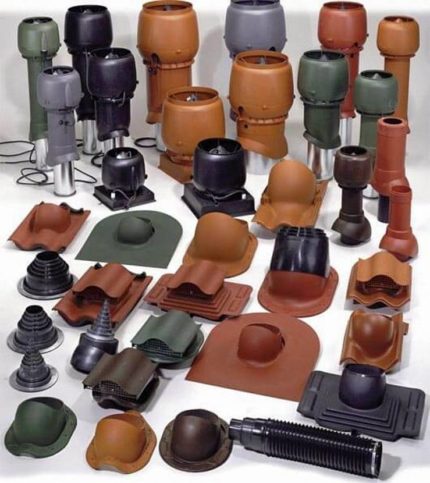
Rubber penetrations are applied on roofs with a different bias. In different models, the height of the sleeve is different. The greater the slope of the roof, the larger the sleeve should be at the penetration.
Plastic products have excellent performance. They are distinguished by a long service life, resistance to low temperatures, UV, humidity. For different types of roofs, penetrations of various configurations are produced.
On the roof there can be several nodes of the passage, which provide the exhaust of exhaust air from the bathrooms, kitchen, basement, and other systems. If the cottage area is small, there can be one passage node.
Typical options for penetration
Relatively recently, there were very few options for the passage nodes. Elements were made in the form of segments of air ducts of square, round section. Mounting washers were welded to them, the design had additional reinforcement due to the presence of stiffeners.
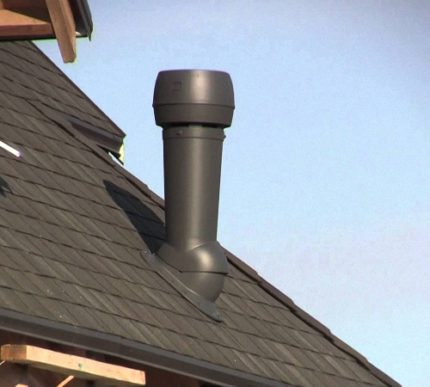
Passage units were installed in reinforced concrete mounting cups - special supporting structures. Glasses were fixed on the roof during the construction process of the building and were equipped with a horizontal platform, which allowed the installation of supporting elements on surfaces with any slope.
Thanks to the development of private housing construction, there are much more varieties of passage nodes that differ in characteristics and operating conditions.
Today, manufacturers offer:
- sparkproof modelsused in exhaust ventilation of enterprises that work with flammable gases;
- valve productsequipped with a condensation ring;
- models without valve.
Choosing a passage unit without a valve designed for an exhaust ventilation shaft, the homeowner receives a simple device. It will be the best solution for a constantly working system that does not require periodic adjustment.
The valve is required, if necessary, to close access to cold air - during the period when the exhaust ventilation does not work.
Passage units equipped with valves differ in various types of control:
- manual - relevant for stably working systems that do not require constant adjustment, and is implemented using a cable, a counterweight, which allows you to adjust the air exchange rate in the house;
- automatic - is made with the help of an electric drive, if necessary, often changing the operating modes of exhaust ventilation.
Accessories can also be equipped with a condensate collection ring.
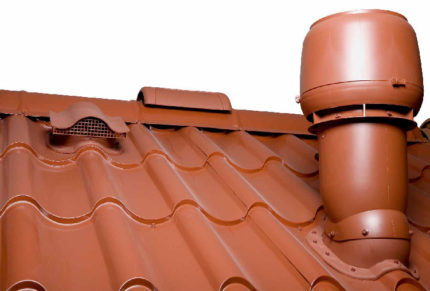
Today, in construction, components for the passage are used, made of polymers or metal. Plastic models significantly facilitate installation work, reduce maintenance costs.
Using metal products, homeowners sometimes encounter noise generated by air currents.
Tuning Recommendations
The choice of the passage unit is carried out depending on the type of ducts used in the installation of exhaust ventilation.
By form they are:
- square;
- round;
- oval;
- rectangular.
Models differ in section size. To ensure waterproofing, the devices are equipped with connecting pads that are mounted before the roof is covered. For example, when mounting the aisle assembly on the roof of a metal tile, foil paper is necessarily used, and all holes are filled with sealant.
When choosing a passage node, it is worthwhile to dwell on products of a domestic manufacturer, as well as on imported models adapted for use in the climatic conditions of your region.

Some models are equipped insulated valvesexcluding the possibility of icing. This ensures uninterrupted operation of automation during severe frosts.
As a prophylaxis, the passage node should be regularly inspected to prevent:
- mechanical debris inside the valve;
- difficulty in rotating the movable elements;
- lack of clearance between the valve and the body, the distance between them is less than 2 mm;
- violation of the integrity of seals, pads;
- the appearance of cracks, other mechanical damage in the inner, outer part.
In the presence of the violations listed above, the passage unit must be replaced.
Also, when choosing an aisle assembly, it is important to distinguish devices for exhaust ventilation from devices for chimneys. The ventilation system is used to discharge exhaust air masses, but incandescent products of combustion are discharged through the chimney, therefore such a passage unit needs additional fire protection.
Rules and features of the installation of the passage unit
When planning independent installation of the passage assembly, it is important to consider the rules of its construction, take into account a number of nuances and ensure during installation:
- tightness - the connecting flange should fit snugly to the surface to prevent moisture from entering the inner layers of the roof;
- lack of barriers for rain, melt water - it is especially important in the off-season, during thaws, when the moisture remaining in the cracks freezes at night, widening the gaps, violating the integrity of the coating, the general tightness of the roof;
- thermal insulation design - which will avoid the formation of condensate, which will gradually destroy the rafters, other elements of the roofing system.
On the top of the passage assembly is located deflector. It prevents the entry into the exhaust duct of birds, small debris, moisture.
Most deflectors have approximately the same appearance. For those who want to stand out, manufacturers offer unique designs.
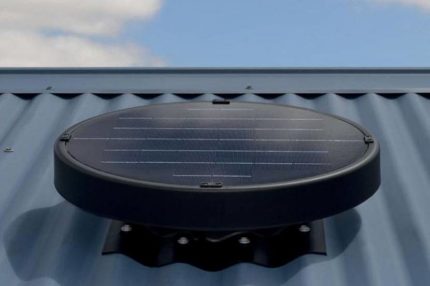
The choice of installation technology for the passage unit depends on the characteristics of the roofing material, the angle of inclination, and other technical characteristics of the roof. All actions during the installation process are aimed at creating a hole corresponding to the size of the duct, its sealing, and insulation.
The general installation procedure involves the following steps:
- Surface marking - the diameter of the hole is made a couple of centimeters larger than the duct. To do this, you can take a pipe segment or make a template that repeats the shape of the exhaust channel. Having attached the air duct to the roof, it is necessary to circle it with a small margin.
- Hole creation - the passage is equipped using technology appropriate to the type of roofing material. For example, when forming a hole from corrugated board, a grinder is not used. Holes are drilled around the perimeter with an electric drill, which are subsequently connected with metal scissors, a hacksaw.
- Trimming insulation layers - this is done carefully so as not to disrupt the configuration of the roofing cake. The penetration is inserted into the resulting hole, insulated.
- Node fixing - the installed unit is securely fixed to the roof surface.
One feature - experts do not recommend using a grinder to create holes in such a roofing material as corrugated board, since sparks appear during operation. The fire burns through the micro-holes in the coating. They are not immediately visible, however, over time, corrosion appears in damaged areas.
If your roofing material is able to withstand the effects of sparks and you plan to make a hole for vent duct output using angle grinders, we recommend that you read the rules safe operation of the grinder.
Option # 1 - ventilation output to a solid roof
Most often, developers choose a metal roof trim. Therefore, we will analyze the installation technology for driving an example of this material.
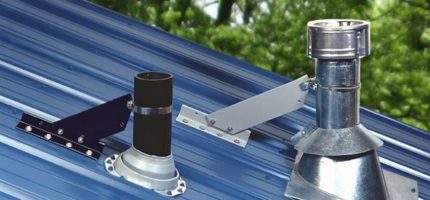
First executed roof marking: The exhaust vent outlet must be located between the rafters. Often the ventilation shaft is installed at the horizontal junction of two sheets of roofing material. The top sheet will cover the passage point plate, and the bottom will pass under the plate.
First, the location of the penetration is determined from the inside. It is easy to outline it by drilling a hole in the metal. From the outside, it is necessary to mark with a marker the place of the proposed hole. To do this, use the template that is included with the passage assembly.
After marking, you can proceed to making holes. For work, you can use manual or electric shears for metal. After the hole in the metal tile is created, it is transferred to the inner layers of the roof.
At the end of work, the installation site is cleaned of small debris, sawdust, thoroughly degreased. In the places of the planned fastening, holes for screws are drilled.
Next comes the turn driving installation. At first mounted seal - the sealing element is applied to the attachment point, carefully crimped in accordance with the topography of the roof. Its lower part is treated with the sealant included in the kit, strongly pressed against the prepared hole. Excess sealant is squeezed out from under the gum, applied to the joints.
Then on top of the rubber band put passage element, fixed with screws. The final stage is installation of an exhaust ventilation pipe, its connection with the channels passing in the house. The outer part of the channel is equipped with droppers, deflectors, umbrellas that provide protection.
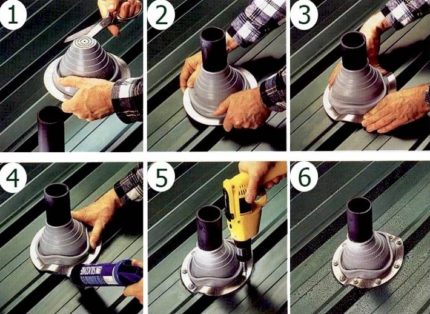
To ensure uninterrupted operation of exhaust ventilation in the winter, it is important to take care of thermal insulation. The presence of insulation will eliminate the likelihood of condensation, freezing of the pipe. The mounting nuances and recommendations for choosing a ventilation pipe for a roof are given in this stuff.
Option # 2 - performing work on a soft roof
The installation technology of the outlet assembly for exhaust ventilation on a soft roof is carried out similarly. Many experts note that the installation is somewhat easier due to the lack of relief of artificial roofing material. During the arrangement of the unit, you do not have to accurately repeat all the bends of the coating, it is enough to tightly attach the elements to the surface, to ensure high-quality insulation.
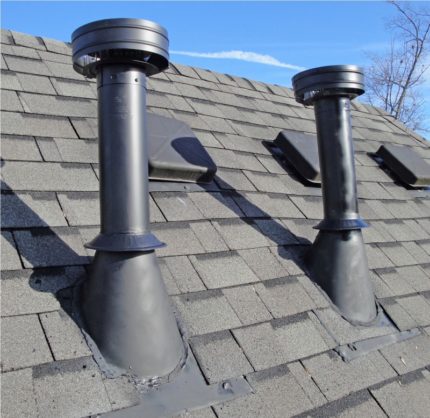
In the process of installation work, special attention should be paid to the tightness of joints, seams. They are carefully processed. If water finds a loophole in the structure, it will cause damage. Even when moisture does not penetrate through all layers of the roof structure, it freezes in crevices, expanding them to significant sizes. Processing all elements with sealant, it is easy to reduce the risks of leaks, to ensure a long life of the roof.
If you decide to install the access node on your own, we recommend that you also familiarize yourself with high pipe fixing options in the roof and the main mistakes that are most often made by inexperienced installers.
Conclusions and useful video on the topic
The outlet point of the exhaust ventilation duct to the roof creates a risk of leaks, violation of the tightness of the roof structure. Therefore, it is important to choose the right equipment for arranging the passage unit, follow the instructions during installation. The videos below will help determine the optimal model and avoid mistakes during the installation of the aisle assembly.
The secrets of a competent choice of roofing will be shared by professionals. After viewing, you can easily determine the model for metal tile or corrugated board with any profile, as well as a product for soft materials:
The video tells in detail about the stages of working with metal. Interestingly, the penetration is installed at the junction of the sheets:
Installation of several nodes of the passage for exhaust ventilation on a flat roof.
From the proposed material, it becomes clear that there are no special difficulties when venting ducts to the roof. Most of the necessary tools are in the arsenal of every home master, and manufacturers offer access points in a complete set, equip craftsmen with fasteners, and high-quality sealant.
If you already have experience in removing exhaust ventilation to the roof, share it in the comments. If you are planning to carry out work, or if you have questions, ask them to our experts and other visitors to the site - the feedback block is located below.

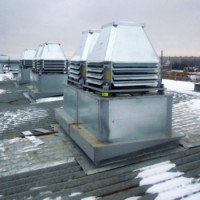 Installation of fans on the roof: features of the installation and fastening of roof fans
Installation of fans on the roof: features of the installation and fastening of roof fans 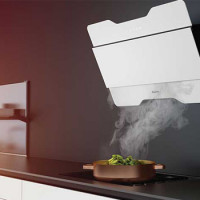 Coal hood: types, device, selection and installation rules
Coal hood: types, device, selection and installation rules 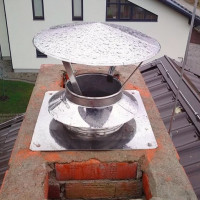 Installing a ventilation fungus on the roof: types and methods of installing a deflector on an exhaust pipe
Installing a ventilation fungus on the roof: types and methods of installing a deflector on an exhaust pipe 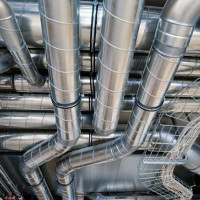 Types of ventilation pipes: a detailed comparative overview of ventilation pipes
Types of ventilation pipes: a detailed comparative overview of ventilation pipes 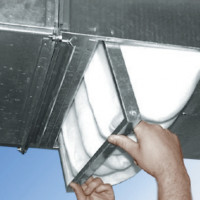 Replacing the filter in the supply ventilation: selection features + filter replacement instructions
Replacing the filter in the supply ventilation: selection features + filter replacement instructions 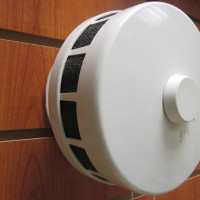 Which supply valve to choose: varieties of valves, features of choice + overview of the best brands
Which supply valve to choose: varieties of valves, features of choice + overview of the best brands  How much does it cost to connect gas to a private house: the price of organizing gas supply
How much does it cost to connect gas to a private house: the price of organizing gas supply  The best washing machines with dryer: model rating and customer tips
The best washing machines with dryer: model rating and customer tips  What is the color temperature of light and the nuances of choosing the temperature of the lamps to suit your needs
What is the color temperature of light and the nuances of choosing the temperature of the lamps to suit your needs  Replacement of a geyser in an apartment: replacement paperwork + basic norms and requirements
Replacement of a geyser in an apartment: replacement paperwork + basic norms and requirements